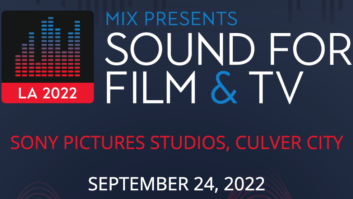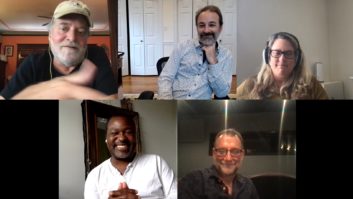
Macau, China (May 15, 2019)—Tony-award nominated sound designer Sebastian Frost is back with his second major production utilising d&b audiotechnik’s Soundscape: the adrenalin-fuelled Elēkrŏn, showing at the Studio City arena in Macau, China.
Produced by London and Hong Kong-based ‘entertainment architects’ STUFISH and set in 2088, Elēkrŏn is an action-packed spectacle, featuring daredevil circus skills, acrobatics and breath-taking stunt driving sequences involving cars, bikes and buggies. It’s a rollercoaster of immersive sound effects and sonic ambition, experienced by a capacity audience of 2,500. Seating is arranged on three sides of the space, leading Frost to specify a horseshoe-shape of hung Y-Series line arrays and V-Series SUBS around the front of the arena, with T10 front fills and delays circling the rest of the area. A complement of nine B2-SUBS underneath the seating completes the system. A series of d&b D80, D20, D12 and D6 amplifiers are on duty, fed by a d&b DS100 Signal Engine processor – the digital backbone of the d&b Soundscape system – offering 64 x 64 matrix Level and Delay in every crosspoint.
“People come to theatre expecting to hear something more akin to a cinematic experience, and d&b Soundscape has really changed the game,” Frost tells PSNEurope. “What we used to do is put all the sound into a single channel output, effectively so you had a mono sound – rarely in musical theatre do you get stereo, because the coverage isn’t even across. People will hear too much to the left, and everyone else to the right. Generally, you’re listening to a mono mix in a theatre. But now, we’ve got to a point where we can split those sounds up individually, make it louder, keep the coherence, the positioning and the imaging. That’s one big factor especially in musical theatre, the biggest advantage it can afford.
“The intention here is to create a soundscape that actually works for everybody within the building. All the same sounds are not from the loudspeaker directly in front of you, not just big arrays down at one end, so you can really build a world in a space this size.”
Most of the action takes place in the center of the arena, but some of the actors move around and their positions are followed throughout the show. Soundscape enables Frost to position sound effects and actor’s voices throughout the space, optimizing the listening experience for everyone in the venue, regardless of where they are seated.
“You have a sense of sound occurring in different places,” he says. “It makes it far more involving. You stop listening to the speaker closest to you and start simply enjoying the full sound experience.”
Frost discovered Soundscape at the d&b audiotechnik HQ in Backnang, Germany. Hailing from a family of musicians and audio enthusiasts, he was fascinated with sound manipulation from an early age. So, when d&b offered him a sneak preview of the processing innovation that was fresh from its R&D department, he jumped at the opportunity.
“What I heard was much more than simple panning or delay of sound; you were not just placing sound objects in specific places,” he recalls. “This was a more scientific approach – the creation of a sound field within which the creative possibilities appear unrestricted.”
Frost first transposed his Soundscape experience to his design for Sting’s Tony award-winning musical, The Last Ship, which started its UK run at Northern Stage in Newcastle in March 2018.
“Sting’s great. He really understands technology, and he absolutely understands a mix and what he’s listening to,” he says. “The musical is very personal to him, and I wanted to ensure the personal stories delivered by the actors are heard from that person – it’s not just about some brilliant Sting tunes.”
The wide but low auditorium at Northern Stage meant there was not much height in the centre to hang a full array. However, it offered a large, 20-metre width. “It seemed like the perfect space in which to try out Soundscape,” says Frost, who, in conjunction with d&b and Sound Stage Services, used d&b ArrayCalc to assess the space. The team specified a horizontal array of six d&b V10P across the top of the stage, each laid horizontal with the horn rotated to present the 110 degrees wide dispersion; six Y10 down the room on the delay line; and 12 E8 front fills. The Y-Series are tucked away up on a bridge above the audience.
The system granted Frost creative freedom in the placement of instruments and actors around the stage as a whole. “It’s great for the audience, as they have a sense of the soundscape, the positioning of all the sound information as you have determined you want it to be heard. This idea that you are within a sound field presents a different listening experience for the audience. Being able to do that is fantastic.
“People were reporting how strong and powerful the cast voices were. They thought they were hearing that person naturally, from a seat at the edge, halfway back, when normally you’d hear it out of a loudspeaker. The sound moves when, and where, the singer does. The way you get separation around the instruments and the voices is a totally different sound, and it’s something that I’ve absolutely fallen in love with since I started using it – it does stuff for me I can’t do with other systems.”
Frost admits that using Q-Lab for control was “a bit of a head scratch” at the beginning.
“I got the guys in rehearsal to take a video of the last run through and I then spent two days locked in a hotel room in Newcastle to watch it with Q-Lab in front of me. There, I plotted every movement, every position of everyone on stage throughout the entire two-and-a-half hour play. I ended up with around 4,000 different positional cues. With Q-Lab, it has to be done individually. You do it for each object, and each move, inputting a timing for each of them. Then, as we started rehearsing on stage, there were bits of tweaking and doing other things.”
The two software modules that accompany d&b Soundscape are En-Space and En-Scene. The former is used to enhance or build an acoustic environment, either indoor or outdoor, based on convolution of the audio signals on a large number of impulse responses captured in acoustically renowned performance spaces, ranging from chamber recital to large concert halls. En-Scene is for object-based signal management. This extends the basic matrix function of the DS100 with an object-based positioning tool for every input.
“I’ve been using En-Space from the beginning of the project,” says Frost. “I started off using it on the band and orchestra – they’re more fixed, sonically – but I have also added it on to vocals, using different reverbs for different scenes. Some scenes are set in a church, which is great because I can use the En-Space reverbs for that, drop the low pass, send the microphones to it, getting it to sound like a natural church. It’s much better than using an external reverb.”
A year into his Soundscape experience, Frost is sold. Soundscape is an evolving innovation – with updates and new software launched to enhance the sound designers’ toolkit and simplify execution – and Frost is on board for the journey.







